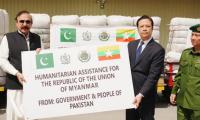BEIJING: A detailed report on Pakistani rice was released by China-Pakistan Agricultural and Industrial Information Platform (CPAIC) which offers a comprehensive overview of the varieties, production, trade, and prospects of Pakistani rice.
According to Gwadar Pro, the report stated that while Pakistan has already become one of the top rice producers and exporters in the world, there are still abundant opportunities to be exploited in the international market.
Pakistan is among the top rice producers and exporters in the world. According to data of the Food and Agriculture Organization (FAO), Pakistan provided over 10% of the world’s rice output and was ranked at the ninth position in 2019.
Rice is the sixth largest export commodity and the largest non-textile export commodity in Pakistan. According to data of the International Trading Center (ITC), Pakistan exported 4.59 million tons of rice in 2019, equivalent to USD 2.3 billion value-wise, both of which accounted for 10% of the world’s total exports, making Pakistan the third largest rice exporter in terms of both volume and value.
The rice grown in Pakistan is mainly divided into Basmati rice and non-Basmati rice. Basmati rice, with slender and elongated grains, aromatic taste, and soft and fluffy texture when cooked, is one of the most favored high-end rice varieties in the international market. Pakistan is the most important growing area of Basmati rice besides India and Bangladesh.
The average cost per acre of both Pakistan’s Basmati rice and IRRI rice was below PKR 50,000 in 2019 in accordance with calculations by the Agriculture Marketing Information Service (AMIS), Directorate of Agriculture Punjab, as listed in the 2020 Q1 report of Pakistan Bureau of Statistics.
This was even lower than other major seasonal crops such as corn, cotton or sugarcane (around PKR 60,000 to 100,000 per acre).
Therefore, rice cultivation boasts competitive edges in Pakistan, and its scale may be further expanded.
Hybrid rice breeding assisted by China is elevating Pakistani rice yield to a new height. Honglian hybrid rice developed by Wuhan University and harvested in 8 demonstrative plots in Pakistan has demonstrated ability to raise production by two times.
A rice variety bred by China’s Yuan Longping High-tech Agriculture Co., Ltd. in collaboration with Guard Agriculture Research and Services are anticipated to double the rice production in Pakistan from 2 tons per acre to 4 tons per acre.
Last year, a total of 500 tonnes of hybrid rice seeds from a seed company in east China’s Jiangsu Province landed in Pakistan to help ensure the country’s grain yield.
Global demand for rice is still growing. Wherein, demand for ordinary rice in Africa and poorer regions of Asia is forecast up with population growth, while the more developed regions in Asia are anticipated to show interest in higher-end fragrant rice. Therefore, market is expected to further expand for both ordinary rice and Basmati rice exported by Pakistan.
As impacted by the Covid-19 epidemic, drought and other factors, the world’s major rice producers – China and Thailand – are expected to see production drop, which will drive up global rice prices.
As a result, Pakistan is anticipated to both expand export volume and increase export price, thereby fetching higher export earnings.
In addition, as India adopted the lockdown policy under the influence of the Covid-19 pandemic, Pakistan may seize export markets occupied by Indian rice.
Prior to that, when EU revised its regulations on the acceptable pesticide residue level in foods in 2018, the Background section of the report pointed out that Basmati rice produced in India contained high levels of tricyclazole (insecticide). This resulted in a decline in the market share of India’s Basmati rice.
China permitted imports of Pakistani rice in January 1, 2006. In February of the same year, the first batch of rice shipped from Pakistan.







